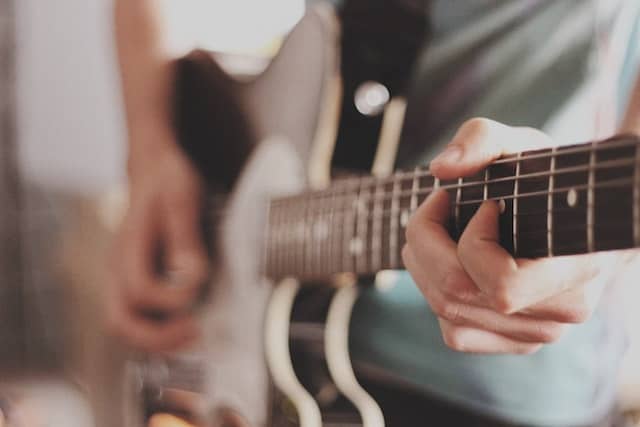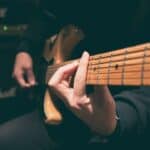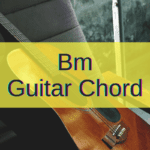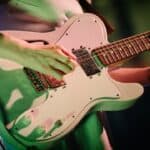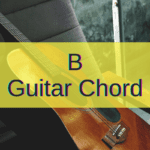For most people I think DADGAD tuning is definitely an alternate tuning, meaning they just use it occasionally, maybe for a song or two.
So I’ve tried to gather some chords that will be useful if you just want a crash course.
To me, DADGAD tuning is all about using the open strings to achieve a unique sound. And moving chord shapes up the neck can give you fresh ideas if you are suffering from musical writer’s block. These chord shapes are chosen to be easy too, so you will usually have a free finger or two to tweak them with.
Although we will be looking at several variants of chords (major, minor, etc.) we won’t necessarily be covering every key for all of them. After all, how often do you play a D# or G# chord in traditional tuning?
These are chords that should help you play or write songs that use common musical motifs without too much work. Let’s get it on!
How do DADGAD chords work
Trying to finger many traditional chords with a combination of open and fretted strings gets pretty messy in DADGAD and would take a big commitment to learn.
If that is something you are interested in then I would advise checking out our other article on DADGAD (Complete Guide) here:
In this article, we will focus a little more on what chord shapes can be shifted around more easily with subtle tweaks when needed.
And feel free to experiment with those open strings played as drone strings when you’re playing sympathetic notes.
In fact, I encourage you to use the open strings as much as possible because the history of this tuning is intertwined with instruments such as bagpipes, ouds, and sitars.
14 essential DADGAD chord shapes you should know
Major and Power Chords (“5” Chords)
First of all, since you have the top 4 strings of the guitar tuned the same as Drop D tuning you have access to power chords. For example:
1. A5 777xxx

And you can strum the bottom three strings whenever they match up well like in chords 10 and 11.
Another way to do power (5) chords is this and you could use this as a barre chord method easily.
2. D5 000200 (E5 chord 222422)

And now to add the F# note back in for our major chords we get…
3. D 004200

4. D 000204

Minor
For minor chords, there are 3 easy chord fingerings that we will take a look at in the key of D.
You can slide them up the fretboard with the open strings to experiment or use them as barre chord shapes (especially farther up the fretboard) since they don’t require extra-human stretches.
5. Dmin 003200

6. Dmin 000203

7. Dmin 003203

Seventh
Having some 7th chords in your arsenal is always a good idea for when you need to change up your sound. Here are some simple shapes for you to use in this tuning.
8. D7 004500

9. D7 054500

Sus2, Sus4
Here is a chord shape that is called a G in some online videos but it is actually a Gsus2 chord with the notes G, A, D. It’s easy as pie.
10. Gsus2 550000

Sus4 chords are just open strings and you can barre, slide, or capo wherever you want on the fretboard. Hey, don’t look a gift horse in the mouth, as they say.
11. Dsus4 000000

Extras
I have seen this chord used online as an E Minor. While all the notes E, B, G, A, and D do fall in the E Minor scale, it is kind of an oddball chord and I think it is technically E Minor 7th add 11.
I guess you could just use it as an E Minor if you want. It’s “same same but different” as they say in Southeast Asia.
12. Emin7add11 222000 (EBEGAD)

Also like this, but moved up the fretboard is an A7sus4/A11 chord.
13. A7sus4 777000 (AEAGAD)

And finally, slightly altering this chord shape and moving it up two frets gives a Bmin7 chord like this:
14. Bmin7 999700 (BF#BDAD)

DADGAD chord progressions
I have tried to choose a lot of chords that will sound nice with open strings of the guitar as you move them up the fretboard.
Or to put it another way, no barre is needed at certain positions for the chord shape to sound good.
That being said, your open strings will probably sound best if you are playing in keys that make use of them.
So since our only open notes are A, D, and G, I would suggest exploring chord progressions within keys that include those notes (D Major, B Minor, G Major, E Minor, C Major, A Minor, F Major, D Minor, Bb Major, G Minor).
I actually tuned my top three strings to Eb (E-G-B-G-A-D) to quickly try all these out with the open G, A, and D notes on the bottom.
They all sound pretty nice but some sound better than others depending on where the notes fall in the scale.
And if you are using a movable chord shape that includes the G string then you should have even more freedom as you only have to worry about A and D open strings.
But don’t overthink this either.
If you are just starting out, I recommend you simply try out these chord shapes at different positions on the fretboard without “barring” with your index finger and keep an open mind.
Let the exotic color chords just happen.
Like Bob Ross the painter used to integrate mistakes into his paintings as “happy little accidents”, you may find a sound that you like.

Hello there, my name is Ramiro and I’ve been playing guitar for almost 20 years. I’m obsessed with everything gear-related and I thought it might be worth sharing it. From guitars, pedals, amps, and synths to studio gear and production tips, I hope you find what I post here useful, and I’ll try my best to keep it entertaining also.

